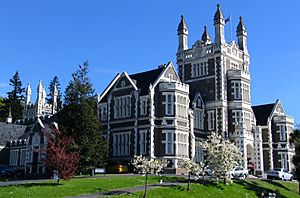Otago Boys' High School facts for kids
Quick facts for kids Otago Boys' High School |
|
|---|---|
 |
|
| Address | |
|
2 Arthur Street
9016
New Zealand
|
|
| Coordinates | 45°52′18″S 170°29′42″E / 45.871597°S 170.495051°E |
| Information | |
| Type | State secondary, day and boarding |
| Motto | Latin: Recti Cultus Pectora Roborant ("The ‘right’ learning builds a heart of oak") |
| Established | 3 August 1863 |
| Sister school | Otago Girls' High School |
| Ministry of Education Institution no. | 377 |
| Rector | Richard Hall |
| Gender | Boys |
| School roll | 875 (February 2024) |
| Houses | Aspinall McIndoe Park Saxton |
| Socio-economic decile | 9Q |
| School Song | Follow Up Otago High |
 Central block |
|
Otago Boys' High School (often called OBHS) is a secondary school for boys in Dunedin, New Zealand. It is one of the oldest boys' schools in the country.
The school first opened on 3 August 1863. Back then, it was known as Dunedin High School. In 1885, it moved to its current location. The main building is very famous for its beautiful design. It looks like an old castle and stands high above the city, offering great views.
Otago Boys' High School has a sister school, Otago Girls' High School. The girls' school is now located where Otago Boys' High School first started.
The school also owns a special lodge in Mount Aspiring National Park. Students often go on exciting field trips there.
Contents
A Look at the School Buildings
The school's main building opened at its current site in Arthur Street in 1885. A famous architect named Robert Lawson designed the Main Tower Block. It cost £14,800 to build. The building uses special stones like blue stone, Port Chalmers breccia, and Oamaru stone. It is considered a very important historic place in New Zealand.
The first headmaster, Thomas Campbell, sadly died before the school officially opened. He and his family were in a boat accident. Two other teachers, George P. Abram and Daniel Brent, helped get the school ready. Mr. Abram became the temporary principal.
The school officially opened on 3 August 1863 with 80 students. Later, Reverend F. C. Simmons became the new headmaster.
As more students joined, new buildings were added. The Shand Building opened in 1914. An archway was built in 1923 to remember those who served in wars. The Fulton Building added more classrooms in 1920. This building was later replaced by a gym and swimming pool complex.
In 1961, the Morrell teaching block was built. A grandstand was also added in the 1960s. In 1967, special science labs were built and named after Sir Archibald McIndoe. He was a famous surgeon and a former student of the school.
A big project to restore and expand the school happened in 1983. This included fixing up the Main Tower Block and adding new buildings. These new buildings were designed to fit well with the old ones. They used similar materials and even had features that reminded people of the old building's castle-like style. This project won an award for its amazing design.
Student Numbers
As of 2025, Otago Boys' High School has 377 students. About 15% of the students identify as Māori.
The school's Equity Index is 377. This means the school supports students who might face challenges in their learning.
School Houses
In 2012, Otago Boys' High School started a house system. Students are divided into four houses. These houses compete in different events throughout the year. The main competitions include athletics, cross country, a haka competition, and a school song competition. There are also smaller events like a food drive.
The four houses are:
- Aspinall (Yellow) – Named after John Aspinall. He was a former student and donated the Aspinall lodge used for school camps.
- McIndoe (Red) – Named after Sir Archibald McIndoe. He was a former student and a famous surgeon who helped injured pilots during World War II.
- Park (Blue) – Named after Sir Keith Park. He was a former student and an important officer in the Royal Air Force. He played a key role in the Battle of Britain.
- Saxton (White) – Named after Charlie Saxton. He was a former student and a very talented sportsman.
Famous Former Students
Many notable people have attended Otago Boys' High School. You can find a full list of them in the.
See also
- List of schools in New Zealand


